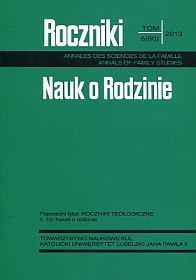Religiousness of People with Disabilities
Abstract
Disability in Poland has recently become a frequent subject of research and investigation. But the studies have mainly focused on psychological issues, as well as a social support of the disabled and their families. A disabled person's religiosity has been hardly ever investigated, and particularly there is hardly any evidence of research on how religion helps to experience disability. The impressive number of studies conducted in the United States, Canada or other countries clearly indicate that religion plays a key role in living a traumatic situation. For the disabled and their families both the individual and social dimension of the faith are of paramount importance; the individual dimension includes prayer and faith in God, the social dimension comprises community meetings, discussions, and intercessory prayers. These practices, in addition to the salvific and spiritual dimension, have a positive effect on improving mental condition of a person, they support treatment and encourage the pursuit of full ability.
References
Durkheim E.: Samobójstwo. Studium z socjologii, Transl. by K.Wakar, Warszawa 2006.
Gail (Frankel) Perry B.: The Relationship between Faith and Well-Being, „Journal of Religion and Health” 2(1998), vol. 37, p. 128.
Janocha W.: Religijność osób niepełnosprawnych i ich rodzin. Studium socjologiczno-pastoralne, Lublin: Wydawnictwo KUL 2011.
JanPaweł II: Cierpienie stawia was w sercu Kościoła, Homily of 5.06.1983, „L`Osservatore Romano” 5-6(1983), p. 32.
JanPaweł II: Krzyż Chrystusa fundamentem nadziei, General Audience of 30.03.1983, „L`Osservatore Romano” 3(1983), p. 18.
JanPaweł II: Przekroczyć próg nadziei, Lublin: Wydawnictwo KUL 1994.
JanPaweł II: Salvifici doloris, vol. 13.
Johnstone B., Glass B. A., Oliver R. E.: Religion and Disability: Clinical, Research and Trainig Considerations for Rehabilitation Professionals, „Disability and Rehabilitation” 29(15)(2007), p. 1155.
Kaye J., Raghavan S. K., Spirituality in Disability and Illness, „Journal of Religion and Health” 41(2002), no. 3, p. 238.
Kirenko J.: Wsparcie społeczne osób z niepełnosprawnością, Ryki 2002.
Koenig H. G.: An 83-Year-Old Woman with Chronic Illness and Strong Religious Beliefs, „Journal of the American Medical Association” 288(4)(2002), p.487-493.
Parlament K. I., Brant C. R.: Religion and Coping, [in:] H.G. Koenig (Eds.), Handbook of Religion and Mental Heath, San Diego: Academic Press 1998, p. 111-128.
Sajdok K.: Cierpienie a wiara, [in:] W. Turek, J.Mariański (Eds.), Kościół w służbie człowiekowi, Olsztyn 1990, p. 249.
Treloar L. L.: Disability, spiritual beliefs and the church: the experience of adults with disabilities and family members, „Journal of Advanced Nursing” 40(5)(2002), p. 597.
Zielińska-Król K.: Ból duchowy jako główna przyczyna wyboru eutanazji, [in:] U. Dudziak, J. Jęczeń (Eds.), Życie czy śmierć, Lublin 2013, p. 91-115.

